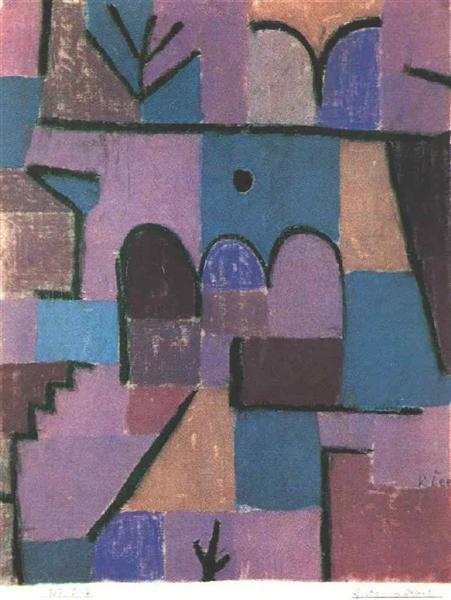Description
Paul Klee's "Eastern Garden" painting, made in 1939, is erected as an emblematic work that encapsulates the uniqueness of the Swiss artist's style, known for his ability to combine the abstract with the symbolic and emotional. In this work, Klee enters a pictorial universe that evokes an exotic garden, a physical and imaginal space that invites the viewer to explore its multiple layers of meaning.
The composition of the painting stands out for its organic structure, where circular and rectangular forms are intertwined in a visual dance that suggests fertility and natural flow of life. They seem to emerge from the Earth, while others seem to float in the air, reflecting Klee's vision on the interconnection of all the elements of the environment. This use of form refers to the influence of Eastern cultures in Klee's thought and aesthetics, a fascination that permeates much of his work.
The color plays a fundamental role in "Eastern Garden". Klee uses a rich and vibrant palette, where bold, yellow and bluish tones predominate. These colors not only delineate space, but also arouse emotions and sensations, achieving a balance between serenity and vivacity. Klee's color use is not limited to mere representation; It becomes a vehicle of expression, evoking climates and moods that transcend the mere visual observation. Each nuance seems to speak not only of the nature of the garden, but about the spectator's psyche.
Regarding the presence of figures, the work may not contain anatomically defined characters, but suggests the possibility of inhabited spaces. The figuration in Klee's work is often understood symbolically, allowing the viewer to project his own narrative in the created spaces. This open approach invites introspection; In this way, "Eastern Garden" can be seen as a refuge where nature and imagination coexist.
Klee, as part of the Bauhaus movement and after the expressionist style, incorporates diverse influences ranging from surrealism to Naive art. Its technique of stacking and organizing geometric shapes and vibrant colors anticipates the development of abstract art in the twentieth century, placing it in a position of continuous interest in the panorama of modern art. Other works by Klee, such as "The Child in the Diablillo" or "The Moon on the city", show thematic and stylistic similarities, inviting the viewer to a similar emotional trip.
It is also important to contextualize "Eastern Garden" within Klee's career, in a period marked by the ravages of war and political agitation in Europe. The work, with its almost dream and evasive nature, could be interpreted as a possible response to outer chaos, a desire to find beauty and peace in a convulsive world. This garden then becomes a symbol of refuge and hope, where adversity is absorbed by the vitality of life that Klee captures on his canvas.
"Eastern Garden" is not just a portrait of a space; It is a manifestation of the connection between the artist, nature and human experience. The work remains a testimony of Klee's unmatched talent to transform everyday life into the extraordinary, reminding us that in each garden, real or imaginary, infinite possibilities for exploration and contemplation are hidden. In his own universe of shapes and colors, Klee makes the viewer not only see, but feels on an emotional tour that resonates much after leaving the garden.
KUADROS ©, a famous paint on your wall.
Reproductions of paintings handmade oil, with the quality of professional artists and the distinctive seal of KUADROS ©.
Art reproduction service with satisfaction guarantee. If you are not completely satisfied with the replica of your painting, we refund your money 100%.

